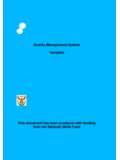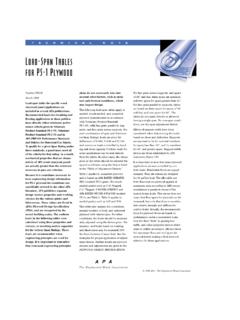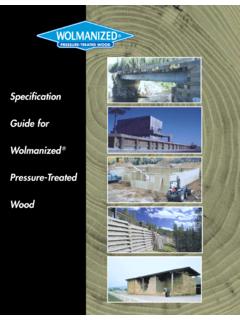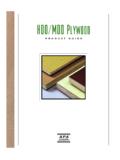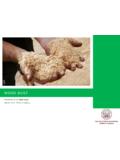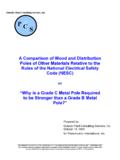Transcription of Forestry and Wood - FP&M SETA
1 0 A profile of the Forestry and wood products sub-sector 2014 A profile of the Forestry and wood products sub-sector December 2014 Forestry and Wood products Sector 1 A profile of the Forestry and wood products sub-sector 2014 CONTENT 1. Executive Summary .. 2 2. Overview .. 2 3. Key features .. 4 Trends .. 4 Challenges .. 4 Drivers for Change .. 5 Standard industrial classification code .. 6 Trade unions active in the sector .. 6 Professional associations .. 6 4. Learner Profile .. 8 Forestry Sector .. 9 Wood Product Sector .. 10 Bibliography .. 11 2 A profile of the Forestry and wood products sub-sector 2014 Figure 1: 2014 tree of the year heteropyxis spp (lavender trees) 1. Executive Summary This sector profile provides a brief overview of Forestry and wood products sectors.
2 It covers the key trends and challenges, the drivers of change and the key role players in the Forestry and wood products sectors. A profile of FP&M SETA learners in the Forestry and wood products sectors is provided. 2. Overview Forestry is a key driver for the development of South Africa s local economies, particularly in rural areas where poverty is compounded by the lack of employment opportunities. The Industrial Development Corporation (IDC) reports that the sector contributes a modest 1% to gross domestic product (GDP) (IDC, 2014). The industry employs approximately 165 000 people, of which 92 700 jobs are attributed to the Forestry sector in particular, the sawmilling, mining timber, pulp and paper and other related industries accounting for the remaining 72 300 jobs ( Forestry SA, 2013).
3 South Africa is lightly forested with a plantation area of 1 268 443 hectares, which represents of the country s land area ( Forestry SA, 2013). This percentage pales in comparison to the plantation areas of 30% in the United States of America and 67% in Japan. The bulk of South Africa s Forestry plantations are located in Mpumalanga followed closely by KwaZulu-Natal. Other plantations are spread across the Eastern Cape, Limpopo and the Western Cape. Pine and eucalyptus are the predominant species in the South African Forestry industry. The plantation forests of South Africa use just 3% of the country's total water resources. Irrigation is never utilised in forest plantation management and therefor rainfall needs to be higher than 750 mm per annum to sustain commercial Forestry (Sabie, 2014).
4 According to the Food and Agriculture Organisation (FAO) of the United Nations, about million hectares of tropical forest was lost annually in Africa between 2000 and 2010 due to illegal logging and other unsustainable practices in the forest sector, accounting for approximately 26% of global forest loss (FAO, 2014). The FAO estimates that globally some 13 million hectares of forest are cut down and converted to other uses such as agriculture each year. The illegal timber trade costs the world economy an estimated US$30 - 100 billion annually. Given the limitations of natural resources, the Forestry industry is tightly regulated - particularly in relation to the environmental impact of Forestry activities.
5 Legislation governing the Forestry industry is listed below: National Forest Act, Act 25 of 2014 (exemptions to Act 84 of 1998) National Forest and Fire Laws Amendment Act, Act 12 of 2001 National Forest Act, Act 84 of 1998 3 A profile of the Forestry and wood products sub-sector 2014 Did you know? The growing and cultivation of trees is called silviculture In April 2013 the minimum wage for Forestry workers in South Africa increased by 56% to R2 229 per month, or per hour (SA Forestry Mag, 2013). Although key players in the Forestry industry were concerned that an increase of this magnitude would make the cost of doing business unprofitable, the largest employers implemented the wage increase successfully.
6 Unfortunately smaller Forestry businesses have, in many instances, not been able to absorb the increase citing that the new minimum wage threatens the viability of their businesses and could result in job losses. An unintended consequence of the wage increase is the speedy mechanisation of Forestry operations which may reduce the number of jobs available in the sector. Until recently research and development in respect of the Forestry industry was limited due to lack of funding. In the beginning of 2014 the Department of Science and Technology awarded a grant of R25 million over a period of three years to Forestry South Africa (FSA). The objective is to boost research and development in the industry, with a particular focus on addressing challenges faced by the industry (SA Forestry Mag, 2014).
7 The three largest employers in the sector are briefly described in Table 1 below. Table 1: largest employers in the Forestry sector Producer Core business Plantation location(s) Komatiland Forests KLF is a subsidiary of SAFCOL whose sole shareholder is the government, represented by the Department of Public Enterprises. It operates 18 commercial plantations comprising a total surface area of 187 320 hectares. Its main business is the conduct of Forestry , timber-harvesting, timber-processing and related activities (Komatiland Forests, 2014). Limpopo Mpumalanga, KwaZulu-Natal Mondi South Africa Owns and manages over 307 000 hectares of Forestry plantations.
8 The organisation employs more than 1 600 people; and has a contractor base of around 15 000 people, most of whom are employed in the Forestry sector. All Mondi SA plantations are certified by the FSC. (Mondi Group, 2014) KwaZulu-Natal Sappi Forests Sappi Forests supplies over 70% of the wood requirements of Sappi Southern Africa, from its own and managed commercial timber plantations of 561 000 hectares. This equates to more than 35 million tons of standing timber. All Sappi plantations are certified by the FSC. (SAPPI, 2014) KwaZulu-Natal Mpumalanga 4 A profile of the Forestry and wood products sub-sector 2014 3. Key features Trends There is a serious focus on responsible Forestry operations and how Forestry activities contribute to the economic viability of local communities both locally and abroad.
9 New Generation Plantations strive to establish plantations that make a positive contribution to ecosystems and communities by sharing knowledge and experience across the global industry (NewGenerationPlatations, 2014). Participants in the New Generation Plantations initiative represent one third of world s certified plantations and manage over 5 million hectares of plantation land. The responsible management of Forestry operations cannot be separated from the priority of achieving sustainability in the Forestry industry. Stakeholders in the South African Forestry industry are committed to implementing and maintaining sustainable plantation forests. Mondi South Africa has engaged in the following activities to achieve sustainable plantation forests: Identification and protection of natural high conservation value areas such as wetlands, grasslands and natural forests and, where practical, linking these areas as effective ecological networks to enhance their biodiversity value; Consideration of the social values of forests and associated ecosystems; Fully respect the rights of indigenous people and communities; Engagement in stakeholder dialogue; and Practising resource efficient Forestry operations.
10 (Mondi Group, 2014) The Forest Law Enforcement, Governance and Trade (FLEGT) Initiative of the European Union has pushed legislators to adopt new measures to stop the circulation of illegally logged timber in relation to consumer concerns about environmental degradation, biodiversity loss and associated climatic changes. In other words, failure to demonstrate legality will increasingly limit access to markets in the years to come, and this also impacts on the South African export of Forestry products. As more and more governments and enterprises embrace new sustainability and legality standards, few will be able to afford "short-cuts" or alternative routes (FAO, 2014).


